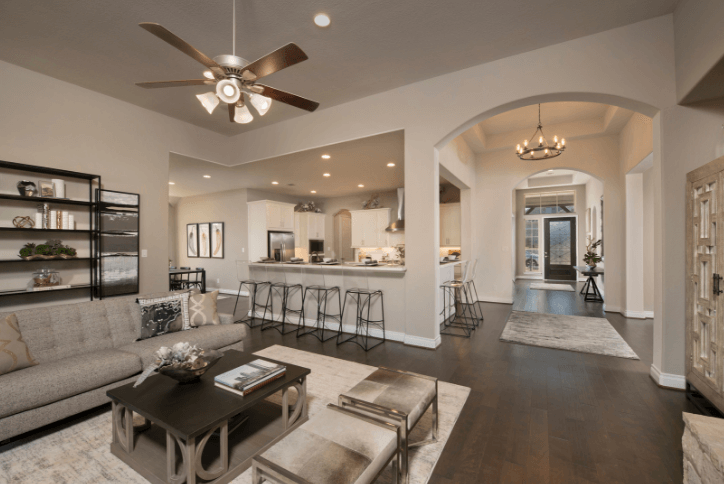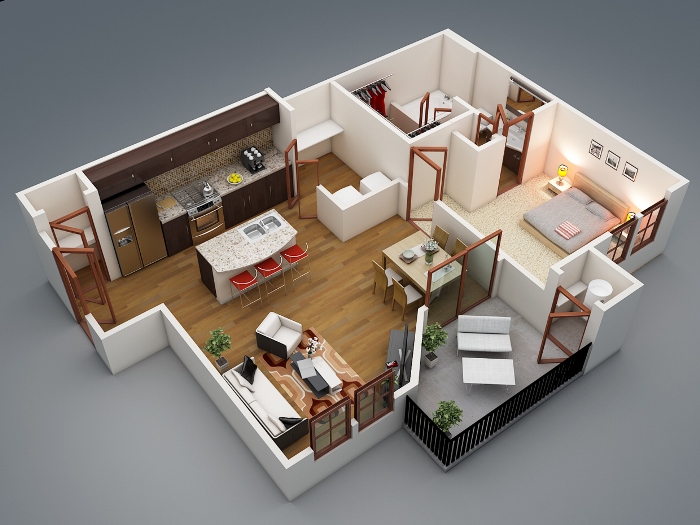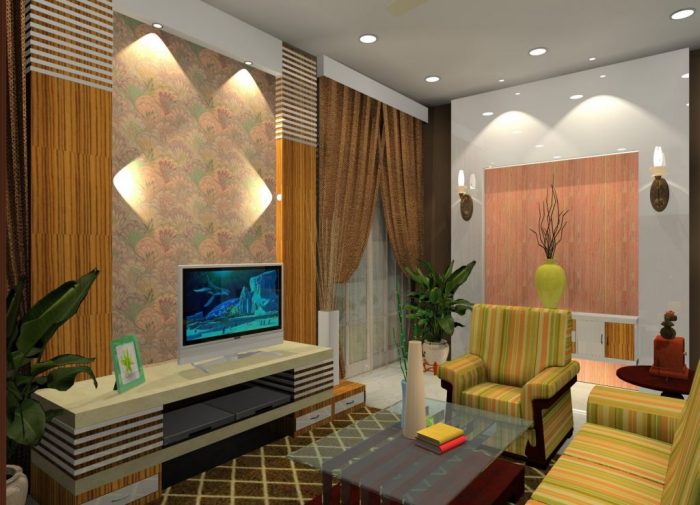1 Floor House Interior Design: A single-story home offers a unique set of advantages, from enhanced accessibility and convenience to potential cost savings. Whether you’re a growing family, a retiree, or someone seeking a more manageable living space, a one-floor layout can be an excellent choice.
This approach presents a fantastic opportunity to create a home that is both functional and visually appealing, seamlessly blending indoor and outdoor spaces.
This guide explores the key considerations for designing a stunning and practical single-story home. We’ll delve into the advantages of open floor plans, discover smart kitchen and living room layouts, and explore creative bedroom and bathroom design ideas. From maximizing natural light to incorporating sustainable design features, we’ll provide insights to help you transform your vision into a reality.
The Appeal of Single-Story Living: 1 Floor House Interior Design

Single-story homes offer a unique blend of convenience, accessibility, and potential cost savings, making them an attractive choice for a wide range of lifestyles. From families with young children to seniors and individuals with mobility concerns, the advantages of single-story living are undeniable.
Accessibility and Convenience
Single-story homes eliminate the need for stairs, making them incredibly accessible for people of all ages and abilities. This is particularly beneficial for families with young children, seniors, or individuals with mobility challenges. The absence of stairs also promotes ease of movement and reduces the risk of falls, enhancing overall safety and comfort.
Furthermore, single-story living simplifies daily tasks such as laundry, cleaning, and meal preparation, as everything is conveniently located on one level. This can be especially appealing to individuals who prefer a more streamlined and efficient living experience.
Potential Cost Savings
Single-story homes often require less construction material and labor compared to multi-story houses, which can translate into potential cost savings. The reduced footprint of a single-story home can also lead to lower energy consumption for heating and cooling, further contributing to long-term cost savings.
Lifestyles that Favor Single-Story Homes
- Families with Young Children:Single-story homes provide a safe and convenient environment for young children, eliminating the risk of falls and allowing for easy supervision.
- Seniors:As individuals age, the ability to navigate stairs can become challenging. Single-story homes offer a safe and accessible living space, reducing the risk of falls and promoting independence.
- Individuals with Mobility Concerns:Single-story homes are ideal for individuals with mobility limitations, as they eliminate the need for stairs and provide a level living space.
Challenges of Single-Story Living
While single-story homes offer numerous advantages, they also present some challenges. One potential limitation is space. A single-story home may require creative design solutions to maximize space utilization and accommodate the needs of a growing family or changing lifestyle.
Additionally, single-story homes may require larger lot sizes to achieve the same square footage as a multi-story home.
Open Floor Plans and Flow
Open floor plans are a hallmark of single-story homes, offering a seamless flow that enhances the feeling of spaciousness. By eliminating interior walls, these designs create a sense of openness and connection between living areas, maximizing the use of available space.
Maximizing Natural Light
Natural light plays a crucial role in creating a welcoming and airy ambiance. Open floor plans allow for maximum natural light penetration by eliminating barriers that might obstruct sunlight. Large windows and strategically placed skylights can flood the interior with natural light, creating a bright and inviting atmosphere.
The absence of walls allows for unobstructed light paths, enhancing the brightness and spaciousness of the home.
Defining Zones Without Barriers, 1 floor house interior design
While open floor plans promote a sense of openness, it’s essential to define distinct zones for different activities. This can be achieved through clever design techniques that create visual separation without constructing physical walls.
- Changes in Flooring:Different flooring materials can delineate different areas. For instance, using hardwood in the living room and tile in the kitchen creates a visual distinction between the two spaces.
- Lighting:Strategic lighting can also define zones. Pendant lights over a dining table or track lighting in the kitchen create focal points and visually separate these areas.
- Furniture Placement:Arranging furniture in strategic clusters can also help define zones. Placing a sofa and coffee table in one area and a dining table in another creates a sense of separation without physical barriers.
Bedroom Design for Comfort and Privacy

A single-story home provides the perfect canvas for creating comfortable and private bedrooms that truly feel like sanctuaries. By taking advantage of the open floor plan and natural light, you can design bedrooms that prioritize relaxation and rejuvenation.
Bedroom Layouts
The layout of your bedroom plays a significant role in its functionality and overall feel. Consider these popular layouts, each offering unique advantages:
- Traditional Layout:This classic layout features a bed positioned against a wall, with bedside tables and a dresser. It is a simple and functional option, perfect for smaller bedrooms.
- Walk-in Closet Layout:A walk-in closet is a luxury that adds storage space and creates a more spacious feel. This layout typically features the bed positioned in the center of the room, with the closet occupying a separate area.
- Open-Concept Layout:For larger bedrooms, an open-concept layout can maximize space and create a sense of flow. This layout often combines the bedroom with a sitting area or a private balcony, providing a multi-functional space.
Importance of Natural Light and Ventilation
Natural light and ventilation are crucial for creating a comfortable and healthy bedroom environment. They contribute to a sense of well-being and promote restful sleep.
- Maximize Natural Light:Large windows allow ample sunlight to flood the room, creating a bright and airy atmosphere. Consider using sheer curtains or blinds to control the amount of light entering the room.
- Proper Ventilation:Adequate ventilation ensures fresh air circulation, removing stale air and moisture. Invest in a ceiling fan or an operable window to maintain good airflow.
Creating a Calming and Relaxing Environment
The design elements you choose can significantly impact the overall mood and atmosphere of your bedroom. Focus on creating a calming and relaxing environment to promote restful sleep.
- Color Palette:Opt for soft and soothing colors, such as pale blues, greens, or grays. These colors create a sense of tranquility and promote relaxation. Avoid overly bright or stimulating colors that can interfere with sleep.
- Textures and Materials:Introduce soft textures like plush rugs, cozy blankets, and linen bedding to enhance the comfort and coziness of the room. Choose natural materials like wood, cotton, and wool for a warm and inviting feel.
- Furniture Choices:Select furniture that is both functional and aesthetically pleasing. A comfortable bed with a headboard is essential. Consider adding a comfortable armchair or a small seating area for reading or relaxation. Minimize clutter and keep surfaces clean to promote a sense of peace and order.
Outdoor Living Spaces
In a single-story home, seamlessly extending living spaces outdoors creates a harmonious flow between indoor and outdoor environments. This approach not only expands your living area but also enhances the overall appeal and functionality of your home.
Creating Inviting Outdoor Living Areas
The design of your outdoor living space should prioritize privacy, functionality, and aesthetics. Here are some ideas to create an inviting and enjoyable outdoor sanctuary:
- Privacy:Consider using fencing, hedges, or strategically placed plants to create a sense of seclusion.
- Functionality:Think about how you want to use the space. A dedicated dining area, a cozy seating area, or a space for entertaining can all be incorporated.
- Aesthetics:Choose furniture, lighting, and landscaping elements that complement the style of your home and create a visually appealing atmosphere.
Landscaping for Enhancement
Landscaping plays a crucial role in enhancing the beauty and functionality of your outdoor living space.
- Privacy:Dense plantings, such as evergreen shrubs or trees, can provide visual screening and create a sense of privacy.
- Functionality:Consider incorporating raised garden beds for herbs or vegetables, or a fire pit for cozy evenings.
- Aesthetics:Use a variety of textures and colors in your plantings to create visual interest.
Choose plants that thrive in your climate and require minimal maintenance.
Lighting for Ambiance
Lighting is essential for creating ambiance and extending the use of your outdoor living space into the evening hours.
- Task Lighting:Install overhead lighting for dining areas or other functional spaces.
- Ambient Lighting:Use string lights, lanterns, or spotlights to create a soft and inviting glow.
- Accent Lighting:Highlight specific features, such as plants, sculptures, or architectural elements.
Furniture for Comfort
Comfortable furniture is essential for making your outdoor living space truly inviting.
- Seating:Choose durable and weather-resistant furniture that suits your style and needs. Consider sofas, armchairs, or benches.
- Dining:A dining table and chairs are essential for outdoor meals.
- Storage:Include storage options for cushions, blankets, or other outdoor essentials.
Closure

Creating a beautiful and functional single-story home requires careful planning and attention to detail. By understanding the unique challenges and opportunities presented by this type of living space, you can craft a home that is both aesthetically pleasing and practical.
From embracing open floor plans and maximizing natural light to incorporating sustainable design features, the possibilities are endless. Whether you’re starting from scratch or renovating an existing home, this guide provides a roadmap to achieving your dream single-story living space.
Quick FAQs
What are some common challenges of designing a single-story home?
One common challenge is maximizing space, especially in smaller homes. Another is creating a sense of privacy in an open floor plan. However, these challenges can be overcome with thoughtful design solutions.
What are some popular interior design styles for single-story homes?
Popular styles include modern, farmhouse, traditional, and contemporary. The choice depends on personal preferences and the overall aesthetic you’re aiming for.
How can I incorporate sustainable features into my single-story home?
You can use energy-efficient appliances, natural ventilation, green building materials, and solar panels to create a sustainable and eco-friendly home.

